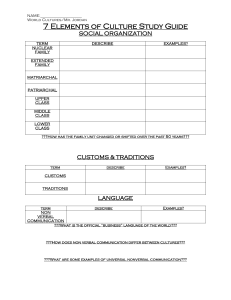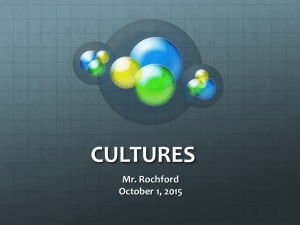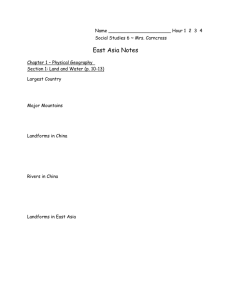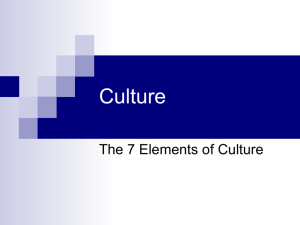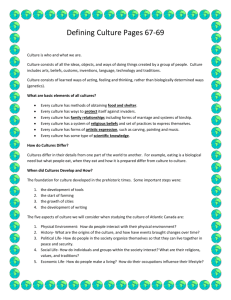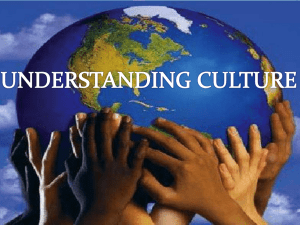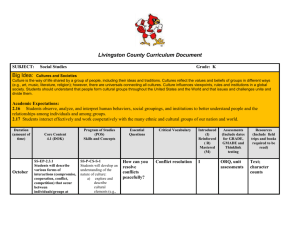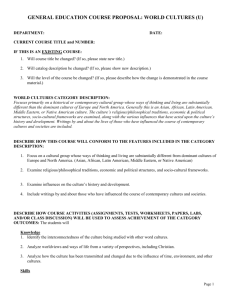What is culture and what it means „intercultural”?
advertisement
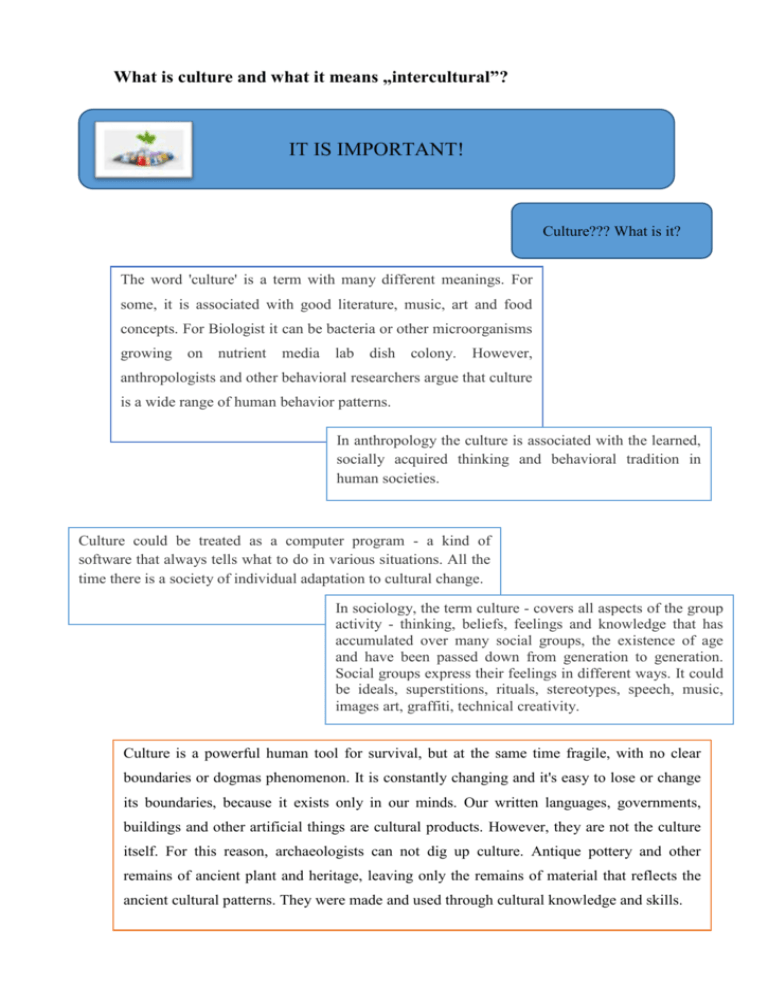
What is culture and what it means „intercultural”? IT IS IMPORTANT! Culture??? What is it? The word 'culture' is a term with many different meanings. For some, it is associated with good literature, music, art and food concepts. For Biologist it can be bacteria or other microorganisms growing on nutrient media lab dish colony. However, anthropologists and other behavioral researchers argue that culture is a wide range of human behavior patterns. In anthropology the culture is associated with the learned, socially acquired thinking and behavioral tradition in human societies. Culture could be treated as a computer program - a kind of software that always tells what to do in various situations. All the time there is a society of individual adaptation to cultural change. In sociology, the term culture - covers all aspects of the group activity - thinking, beliefs, feelings and knowledge that has accumulated over many social groups, the existence of age and have been passed down from generation to generation. Social groups express their feelings in different ways. It could be ideals, superstitions, rituals, stereotypes, speech, music, images art, graffiti, technical creativity. Culture is a powerful human tool for survival, but at the same time fragile, with no clear boundaries or dogmas phenomenon. It is constantly changing and it's easy to lose or change its boundaries, because it exists only in our minds. Our written languages, governments, buildings and other artificial things are cultural products. However, they are not the culture itself. For this reason, archaeologists can not dig up culture. Antique pottery and other remains of ancient plant and heritage, leaving only the remains of material that reflects the ancient cultural patterns. They were made and used through cultural knowledge and skills. FACTS BOX Facts??? Interesting! The world currently has 256 definitions of culture. Culture is the result of hands and mind. Cultural history: art history, art history, philosophy, history, technology history, culture - all what differs person from the animal. Ciceron 47 years before Christ first uttered the word culture. However, even in the middle ages that was not discussed. Culture was, but no one talked about it. French cultural understanding The French say that culture is everything that is civilization, good manners at the table, and the like, nice clothing, etc. etc. They argue that the cradle of civilization is none other than France. Vive le France! American cultural understanding Americans are debating about the pain, AIDS, crime, poverty, information technology culture Experts have confirmed 5000 - 6000 the world's languages in existence, claiming that about as well as a history and cultures The world thrives around 1000 different cultures, among them - hundreds in Europe IT IS IMPORTANT! The person is usually thought of three levels of culture: In his country, homeland, culture, identity, the culture that is specific to each community. FIRST • When people talk about Italy, Finland, India, and the Japanese culture, they are referring to a common language, traditions and beliefs that each of these nations applied separately from the others. In many cases, people are spread out and attempting to preserve their culture and traditions is doing because it is so programmed, so did their parents and other relatives, they are taught in school and in their community. SECOND Ethnic subcultures that exist in the country, which is rich in a variety of societies where people came from different parts of the world • A good example is the United States, there is a rich variety of ethnic groups, which are integrated into the society, but to hold on to their identity. Time spent in a foreign country and integration into society due to factors that subculture mixed and blurred their traditions, they are mixing. THIRD Cultural universals. No matter where people live in the world, they recognize that there are universal features of all cultures. • It is common for all cultures (language, common work, sport, body jewelry, dancing, gifts, hospitality, sense of humor, wedding, funeral rites, and so on.). So this is a whole culture of all things around us around. Culture influences both themselves within certain limits, and the environment around us and everyone that phenomenon and poor. TIME FOR DISCUSSION! Is the culture is necessarily associated with a group of people, whether there is a „culture of the individual“? What are the elements of culture? Is it possible to create a global "cultural map"? Does the culture changing? Why and how? How much culture is related to the behavior of individuals and groups? Can a person have multiple cultural backgrounds - and what does it mean? TIME TO PLAY! „The onion of diversity“ Never mind what group, we have a lot in common and many differences, which complement each other. A small exercise to discover it – fun! Resources needed Group Size Time - Big free space in a room From 10 to 40, even number of participants required Up to 30 minutes Step by Step: 1. Participants are asked to form an inner and an outer circle (standing for the onion layers), people face each other in couples. 2. Each couple has to find (very fast) one thing (habit, aspect, background, attitude...) they have in common and find one form of expression for it (you can leave the form of expression free or indicate every time a different one: “Sing a song”, “make a short mime”, “create a poem in two lines”, “express it with noises”, “express it with a symbol”...). 3. Once this is done, the outer onionskin moves to the right and each new couple has to find a similarity and express it. You can as well give indications for the type of similarity (favourite food, what I disliked in school, family, music, habit, attitude, political statement...), going every time a bit “deeper” in our onions. 4. The couples can change several times, till the circle is finished (depending on group size). A more difficult variation would be to search for differences in the couple and to express their complementarities (or find an expression / situation integrating both).

